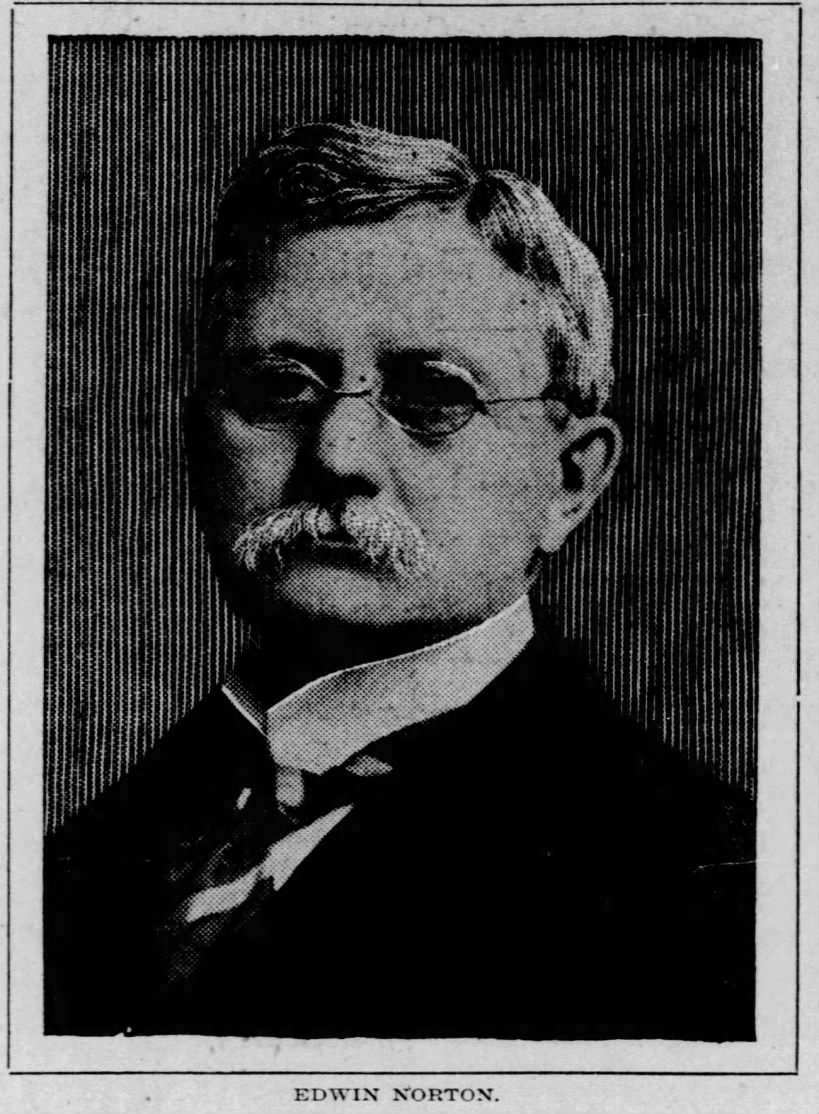Imagine that you are in a grocery store right now. Close your eyes. Do it. I promise no one is looking. What do you see? Forget that, if you have your eyes closed, you can't read. This was not a well thought out exercise. So imagine with your eyes open, the rows of self-checkout counters and shoppers pushing carts with self-determined front wheels. Go deeper. What is on the shelves? Bags of potato chips, boxes of macaroni-style dinners, brightly colored cereals, and an entire aisle devoted to canned goods: soups, vegetables, beans, meats, and anything else you can think of, right?

Photo by Aleksandar Pasaric from Pexels
Now you're asking yourself, "What does this have to do with the first political campaign button in 1892?" To answer that, you are going to have to stick with me on this one. Stay close now.
Canned goods were born before any person alive today. We take them for granted. We have likely never thought about where they came from or who made them. The first tin-plated can was introduced to the American public in 1818 by Peter Durand. That same year, Illinois became the 21st state and future first lady, Mary Todd Lincoln was born. Durand, an English merchant, known as the Father of canning, was granted the first patent by King George III eight years earlier in 1810.
For the next fifty-five years, England (specifically Cornwall) dominated the tin industry. Their workforce was aptly trained, and they had some of the best tin mines around. As a result, they could charge whatever they wanted, and as the canned good revolutionized the way that we eat, the world was willing to pay.
Come to the year 1868. Edwin Norton, operating under the name "E. Norton," started his own tin can making business in Toledo, Ohio. At this time, the tin plates were imported from Europe and turned into cans stateside. After a few years, Edwin moved his business to Chicago, and in 1873, his brother joined the operation, becoming Norton Bros. Over the next decade, the brothers patented several canning machines and became experts at Japanning, a tin decorating method.
Chicago Tribune. (1901, March 27). Edwin Norton [Photograph]. Newspapers.com. https://www.newspapers.com/clip/60344223/chicago-tribune/
In 1888, the Republican National Convention was held in Chicago, Illinois. Norton, a now prominent and staunch Republican, was likely in attendance as Benjamin Harrison, grandson of former President William Harrison, was nominated for President. Harrison won on the platforms of protecting the American industry and a new rejuvenated Republicanism. His running mate, Levi P. Morton, a New York Banker, was also selected by the convention.
One of his first acts was working with congressional Republicans to pass the McKinley Tariff, which went into effect in 1890. This tariff was good news for Norton Bros. It ultimately increased tariff rates for many manufactured goods made outside the U.S., including tin plating. Voters saw the bill as a play towards wealthy industrialists. This reaction had massive impacts on that year's fall elections, which leaned heavily in the Democrats' favor.
Norton Bros. seized the opportunity to pioneer the newly formed American tin plating Industry. In 1890, they began their own tin plating outfit. Norton was by far not the only industrialist pushing for stronger protections. Five years prior, after the Republicans failed to capture the Presidency from Grover Cleveland, many of the most influential businessmen, representing various trade areas, gathered together. Some of the industries present were steel, rail, and iron ore. From this meeting, on January 15, 1885, The American Protective Tariff League was born. The group's members considered themselves "Defenders of American Labor and Industry."
In 1891, Norton Bros. were heralded in a Lansing, Minnesota, paper, The Mower County Transcript, for creating, "The First American Tin Can," made with American-made tin plates. It was called "the first fruit of the McKinley Tariff." While many saw it as a win, others were more skeptical.
Specifically, The Chicago Tribune, who published a scorching editorial claiming there was nothing "American" about Norton's tin cans. In it, they accused them of importing everything from materials to labor and, in turn, cheating the system. In response, Norton printed their own letter conceding that while they used imported steel plates and tin for their initial experimentation, they were in the process of switching over to American sources and would be using them exclusively very shortly. As for their use of Welsh labor, they claimed that while the workers were originally of Welsh origin, many had been in the country long enough to naturalize.
In 1892, however, in a dual attempt to showboat their new tin plating abilities and bolster the Republican ticket, Norton Bros created thousands of campaign buttons. They were quickly snatched up at the Republican National Convention in 1892 in Minneapolis, MN. While many were confident of a Harrison victory, Senator James G. Blaine of Maine also had his hat in the ring. In anticipation of the convention, Norton Bros. fashioned two different buttons, one for Harrison, another for Blaine. The Daily Inter Ocean Newspaper in Chicago mentioned the buttons in possibly the first recorded use of the term, on June 11, 1892. The article states, "When the delegates reached their state headquarters, they found hundreds of Harrison buttons made of American tin-plate by Norton Bros. of Chicago. The front bears a picture of President Harrison on the raised center with "Harrison and Protection, 1892" around the edge.".

Norton Brothers. (1892). Harrison and Protection [Photograph]. The Busy Beaver Button Museum. https://www.buttonmuseum.org/buttons/harrison-and-protection
Likewise, Blaine’s button also had the same logo of “Blaine and Protection,” which may symbolize that the idea of “Protection” far outweighed the candidate behind it.

Norton Brothers. (n.d.). Blaine and Protection 1892 [Photograph]. Hake’s Auctions. https://www.hakes.com/Auction/ItemDetail/200494/IMPORTANT-PREVIOUSLY-UN…
What makes these particular pins a mystery is that there were no other pins like it at the time. The first patent for the button, as we know it, was not granted until four years later, in 1896. That year three different button patents were issued to the now-famous Whitehead & Hoag Company. They went on to be the leading producers of buttons through WW2. At that time, companies and politicians alike saw them as a cheap advertisement opportunity.
Scene at the Convention Hall when Harrison was Nominated, 1892. (1896, June 11). [Drawing]. In The Daily Inter Ocean (XXI.,79, p. 1).
Later that same year, Norton sent “several tons” of round tinplate badges to the General Secretary of The American Protective Tariff League, Wilbur F. Wakeman. Each of the tinplate badges bore similar inscriptions to the Harrison and Blaine buttons reading, “Harrison-Reid and Protection 1892” around the edges. Etched in the center are the lines,
“Protections banner guard our land,
From England’s greed and Pauper pay,
And when I play Great Britain’s hand,
Please take me for a blooming jay.”
Norton Brothers were not ones to shy away from mixing politics and business. For them, the two were likely intertwined. During the 1899 Norton Bros. workers strike, workers claimed that before the Harrison re-election bid in 1892, Norton Bros. docked workers pay 15%, citing hard times. They went on to claim that their pay was to be reinstated if Harrison won the re-election. In the end, Harrison lost to President Grover Cleveland, who had also been the President prior to Harrison from 1885-1889. After the defeat, only 5% was returned, leading to a general strike in 1896 in which an additional 10% was restored. Despite the pay raise, ill feelings still lingered and resulted in the 1899 strike.
In 1901, a merger of 60 canning companies from all over the nation (including Norton Bros.) formed American Canning with Edwin Norton as its President. A year later, he stepped down from the role of President. In the sell-out agreement, those who left agreed not to re-enter the business for 15 years. Norton, however, realized that the agreement did not include his son. Norton's son, along with T.G. Cranwell, who is regarded as the company founder and its first President, formed Continental Canning Company in 1904. Fifty years later, Continental Canning grossed $616 million in that year's sales.
The next time you find yourself wondering about the grocery store aisles, think of the quote from American Jazz Guitarist Pat Metheny, "I'm always trying to find connections between things. That art is the juxtaposition of a lot of things that seem unrelated but add up to something recognizable."
Sources:
Can Manufacturers Institute. (n.d.). History of the Can - Can Manufacturers Institute | Washington, DC.
Can Manufacturers Institute | Washington, DC. https://www.cancentral.com/can-stats/history-of-the-can
A curious campaign badge. (1892, October 1). Red Lodge Picket.
https://www.newspapers.com/image/171677813/?terms=a%2Bcurious%2Bcampaign%2Bbadge
Dilworth, J. A. B. (1891, February 4). The Chicago Tin Plate Humbug. The Chicago Tribune.
https://www.newspapers.com/clip/60218994/chicago-tribune/
Gordon, N. S. (1891, January 7). The first American tin can. Mower County Transcript.
https://www.newspapers.com/clip/58269624/mower-county-transcript/?xid=865
Halasz, R. (n.d.). Continental Can Co., Inc. | Encyclopedia.com. Encyclopedia.Com.
https://www.encyclopedia.com/books/politics-and-business-magazines/continental-can-co-inc
Lying for a Purpose. (1891, January 15). Decatur Weekly Republican.
https://www.newspapers.com/clip/59156969/decatur-weekly-republican/?xid=865
The McKinley Tariff of 1890. (n.d.). History, Arts, and Archives| United States House of
Representatives. https://history.house.gov/Historical-Highlights/1851-1900/The-McKinley-Tariff-of-1890/
Metheny, P. (n.d.). Pat Metheny Quote. A-Z Quotes. https://www.azquotes.com/quote/119183
Organizer of Tin Can Trust passes away. (1915, January 2). Chicago Tribune.
https://www.newspapers.com/clip/58265112/obituary-for-a-nlzg-r-norton-aged-69/?xid=865
Reilly, M. (2017, March 24). Tin Company Histories. Fred Keller History Museum.
https://kellerhistorymuseum.org/antiqibles/antique-advertising-tins/tin-company-histories/#n
Rush for Home. (1892, June 11). The Daily Inter Ocean.
https://www.newspapers.com/clip/58267729/the-inter-ocean/?xid=865
Sautter, R. C. (n.d.). Political Conventions. Encyclopedia of Chicago.
http://www.encyclopedia.chicagohistory.org/pages/986.html
Spetter, A. B. (2016, October 4). Benjamin Harrison: Campaigns and Elections. Miller Center.
https://millercenter.org/president/bharrison/campaigns-and-elections
Strike at Maywood. (1899, March 29). The Inter Ocean.
https://www.newspapers.com/clip/353720/the-inter-ocean/?xid=865
They Make Sample Tin. (1890, December 23). Chicago Tribune.
https://www.newspapers.com/clip/58267243/chicago-tribune/?xid=865
Wikipedia contributors. (2020, September 17). Benjamin Harrison. Wikipedia.
https://en.wikipedia.org/wiki/Benjamin_Harrison
Wikipedia contributors. (2020a, April 24). Peter Durand. Wikipedia. https://en.wikipedia.org/wiki/Peter_Durand

